9
Metamorphosis
Ever since we realized that the caterpillar was the infant form of the butterfly, we have been fascinated by insect metamorphosis. It is difficult to think of any other natural transformation that is so dramatic, especially given the short time frame of an insect’s life. We still do not fully understand the physiological changes involved.
9.2 • Incomplete metamorphosis
9.4 • Transformation within the pupa

A cicada struggles free of its larval casing. Most insects will undergo a similarly marvelous transformation to reach their adult form.
types of life cycle
Insects are not the only animals that change their form through their lives, but for human observers they are the most dramatic and easily observed shape-shifters.
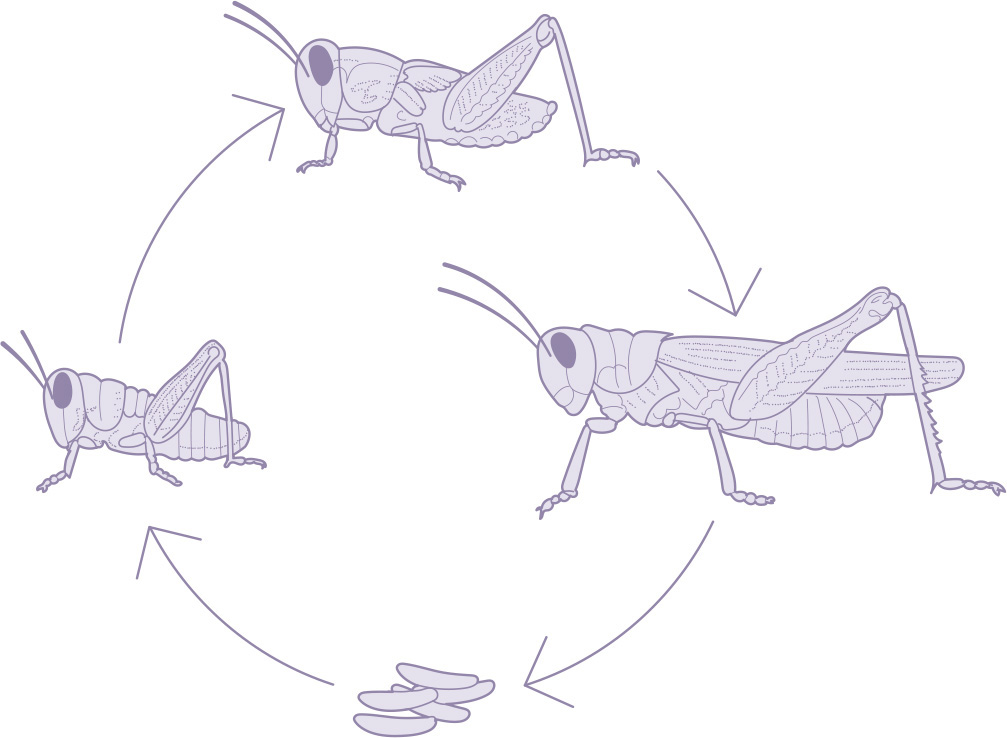
This diagram shows the egg-to-adult life cycle of a hemimetabolous insect, involving larval growth and then a final molt to the winged adult form, or imago.
Most insects begin life within an egg, and most have a nonreproductive growth phase, with regular molts to allow this growth, before reaching adulthood. This is the point where growth ceases and the insect becomes capable of breeding; in most cases, it also becomes winged.
The insect species that have changed the least from the world’s earliest examples of insectkind show relatively little change in appearance as they grow. The silverfish, for example, resemble miniature adults from the moment they hatch out from their eggs. They become larger with each molt but never develop wings. They also continue to grow (very slowly) and molt regularly after becoming reproductively mature.
Insects that are winged as adults but do not pass through a pupal stage are known as hemimetabolous, meaning that they undergo an incomplete metamorphosis. They include the grasshoppers, crickets, true bugs, dragonflies, mantids, mayflies, and stoneflies. Their adult form may be very similar in appearance to the larval form that preceded it. Larvae of hemimetabolous insects are active with well-developed legs and are easily mistaken for adult insects. Their lifestyle and diet are usually similar if not exactly the same as the adult’s, though in the case of species that live underwater as larvae, the transformation is more dramatic.
The insect groups that have diverged most dramatically from their ancestors are the holometabolous species—those that pass through a mostly inactive pupal stage during which their bodies are remodeled from their larval form. They include the butterflies and moths, bees, wasps, and ants, true flies, and beetles. Larvae of holometabolous insects are, in general, less active, softer-bodied, and “vermiform” (wormlike) compared to those of hemimetabolous insects.
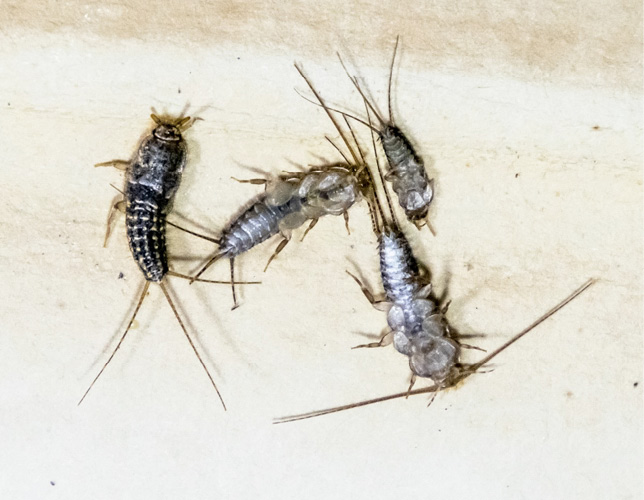
Silverfish have no distinct adult stage—their growth pattern is sometimes known as ametabolous metamorphosis.
evolution
Other arthropod animals also go through a series of molts as they mature, but the development of a pupal stage has only evolved in insects, and first occurred some 280 million years ago. Much debate has raged through the last couple of centuries over how complete metamorphosis evolved, and the answer is still not fully clear, but it is likely that holometabolous insects evolved from hemimetabolous ones that began to hatch from their eggs at an earlier, more embryonic stage of development. Some hemimetabolous insects today, such as damselflies, do hatch in a much less developed and more vermiform state—sometimes known as a prolarva—which quickly molts to a more adultlike second-instar larva. Given the right conditions, such undeveloped larvae can make use of different resources from the adult insects. This allows the species as a whole to use a broader niche. The majority of modern insect species on Earth are holometabolous.
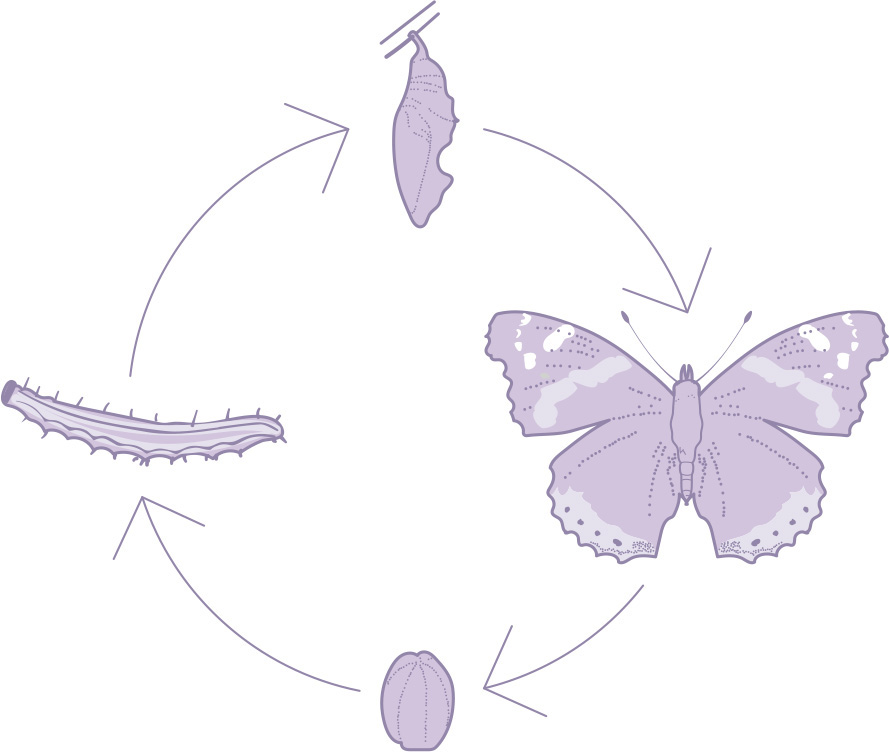
This diagram shows the four-stage life cycle of a holometabolous insect: from egg, to larva, to pupa, to winged adult (or imago).
INSECT LIFE SPANS AND LIFE CYCLES
It is often said that a mayfly only lives for one day, but that is only true if we disregard the preadult stages of its life. Many insects are in fact surprisingly long lived.
The periodical cicadas (genus Magicicada) of North America live much longer than most small mammals. However, virtually all of that life is spent as a larva, living underground and sucking sap from tree roots. On a warm night in their 17th spring (or 13th in some species), they finally emerge and molt to their adult form. They live for no more than six weeks as adults. The synchronous emergence of each population helps ensure that all individuals can easily find a mate, and that their sheer numbers ensure that predators do not put the overall population at risk.
Within social insect colonies, the workers live briefly as adults but the queens can be very long lived. A queen ant may live for 30 years; a queen termite for up to 50. Mature males are short lived, but queen termites have the same breeding partner (the king) for many years.
In many parts of the world, insects will spend months inactive, as weather conditions are unsuitable (too cold, or too hot and dry). When the insect passes this period in an otherwise active form (larva or adult), this is known as hibernation (in winter) or estivation (in summer) and it can extend the total life span considerably. Adult Brimstone Butterflies (Gonepteryx rhamni) hibernate and may thus live for 10 months or so as adults, while most other butterflies in temperate zones overwinter in earlier life stages and live only a couple of weeks in their adult form.
Some other insects are able to accelerate their life cycle if conditions are favorable. The Vagrant Emperor Dragonfly (Anax ephippiger) of Africa is a nomadic species that sometimes completes its breeding cycle much more quickly than normal, allowing it to make use of temporary pools left by heavy rainfall.

A queen termite can live for several decades, during which she will lay millions of eggs.

An adult periodical cicada would have spent the first 17 years of its life as a subterranean larva.
A slow pace of life
In the coldest parts of the world, even summer days may be too cold for much activity. Insects living here tend to have far longer lives than their relatives in warmer climates. Hawker dragonflies (family Aeshnidae) in the far north can take four or five years to reach maturity, while those in warmer countries usually take less than one year. The Arctic Wooly Bear Moth (Gynaephora groenlandica), the most northerly living moth species, takes up to 15 years to complete its life cycle, most of that as a caterpillar.

Because it lives for almost a full year in its adult form, the Brimstone Butterfly has tougher wings than other, shorter-lived species.
incomplete metamorphosis
Although less dramatic than complete metamorphosis, incomplete metamorphosis still has the power to amaze, as anyone who has witnessed a dragonfly clambering from its larval skin will attest.
Some insects that undergo incomplete metamorphosis are highly mobile and active from the moment they hatch. Even as young larvae they may be formidable predators, and are certainly better able to escape danger than holometabolous larvae. A bush cricket larva in its first instar may be only a tenth of the size it will eventually attain, but it is a near-perfect miniature of an adult, down to its elongated antennae and leaping hind legs. However, it has only very small wing buds, and its abdomen is proportionately small as its reproductive organs have yet to fully develop. As it passes through successive molts, its abdomen and wing buds become larger, and (in females) the ovipositor becomes visible in later instars.
Some hemimetabolous insects hatch as a less developed prolarva stage. The prolarva of a damselfly has no legs and no feeding mouthparts but is capable of limited movement. If it hatches out of water (which can occur if the pond in which its egg was laid has dried up in hot summer weather), it will wriggle its way to water, where it will molt to its long-legged, actively feeding, second instar.

Bush cricket larvae are much like adults but with different body proportions and no wings.
The process of molt is triggered and regulated by the interplay of various hormones. When the juvenile hormone levels drop in the final larval instar, the next molt will be to the fully adult stage. The process of molt is the same as between larval instars, but in the case of aquatic insects, the larva usually fully exits the water first. Under its larval cuticle, the adult cuticle has developed, complete with whatever modifications are required—gills may no longer be present, and mouthparts may have assumed different proportions.
After it has cracked through its larval cuticle, extracted its antennae and all six legs intact, and climbed free, the newly emerged adult insect will need to transform its tiny, crumpled wings into functional flight-ready structures. It does this by swallowing air, thus increasing the pressure of the hemolymph in its thorax. This forces hemolymph into the wing veins, causing them to expand and stiffen.
egg size
It is widely held that hemimetabolous insects lay larger eggs than their holometabolous counterparts, and that their eggs take longer to hatch. This is what we would expect, intuitively, as their hatchlings appear to be so much more developed, and across several insect groups this is indeed what we find. However, there are so many exceptions (due to lifestyle specializations of various kinds) that, on average, there is no difference in egg size—in fact, the largest eggs of all are laid by the holometabolous carpenter bees.

The lifestyle of larval grasshoppers and crickets remains broadly similar once they reach adulthood—except that they are also ready to breed.

The emergence of a dragonfly: Extricating itself from its larval cuticle requires considerable agility.
full metamorphosis
The transformation of plump, crawling caterpillar into colorful, fast-flying butterfly is one of the greatest marvels nature has to offer, and the details of this process are no less marvelous.

Some caterpillars spin a protective silk cocoon around themselves before pupation.
The pupal stage of development is what separates the holometabolous insects from the more primitive hemimetabolous species. When it enters its pupal stage, the insect molts out of its final larval cuticle to reveal the pupal cuticle beneath. The pupa is typically very different in appearance from the larva. It does not feed and, in most cases, is fixed to the spot and capable only of limited wriggling movement. For this reason, pupae are usually well camouflaged or otherwise hidden.
When an insect larva is ready to pupate, it stops feeding and begins to seek a suitable site for pupation. Among Lepidoptera, for example, hawk moth larvae climb down from their food plant and seek out a patch of soft ground, burying themselves in the earth. Butterfly caterpillars often anchor themselves to a vertical plant stem, or hang by their tail ends from a horizontal twig. Many Lepidoptera larvae use silk produced from their labial glands to stick themselves in position before pupating, and some spin a protective cocoon of silk, within which they pupate. The cuticle of the newly formed pupa soon becomes firm. Those that hang from twigs often resemble dead leaves, while others may be disguised as bird droppings, thorns, buds, or curled-up shards of bark.
Ant, bee, and wasp larvae usually pupate within the nests that their mothers dug or built for them, and within which they spent their larval lives. Social bees, ants, and wasps guard their colony’s pupae with vigor, just as they do the eggs and larvae. In honeybee nests, the worker adults seal up the larval cells, once the larvae inside pupate, for extra protection. Some other pupae, though, are far from immobile. Mosquito larvae are aquatic and pupate while still in the water. The pupae, known as “tumblers,” float on the surface of the water but can swim and dive if they are threatened. The adult mosquito emerges at the water’s surface—it is light and long-legged enough to be supported by the water’s surface tension. The larvae of parasitoid insects usually break out of their host’s body when mature (causing the death of the already fatally injured host) and pupate on its outer surface, so that the adult insects can fly out into the air when they emerge.
chrysalids
Often the words pupa, cocoon, and chrysalis are used interchangeably. However, only pupa is the correct term for the stage between larva and adult in any holometabolous insect. Cocoon refers to the silken case inside which a larva may pupate, while chrysalis is the pupa of a butterfly. The word chrysalis (plural chrysalids) comes from the Greek chrysos, gold, as some chrysalids have reflective golden markings. The Cream-Spotted Tigerwing (Tithorea tarricina) of South America has an entirely shining golden chrysalis, the color produced by the layered structure of its cuticle, which reflects multiple wavelengths of light.

Honeybee larvae pupate inside the cell where they spent their larval lives.
transformation within the pupa
Some pupae are quite beautiful, but most are unimpressive—if not downright ugly—to look at. However, that tough and featureless shell hides a minor miracle of engineering occurring within.

Remodeling a hawk moth caterpillar into its very different adult form requires breakdown and rebuilding of many body structures and tissues.
At first glance, a pupa may bear no obvious resemblance to the larva it was, nor to the insect that it will become. However, it is usually possible to make out the segmented abdomen and the folded wings. Some moth pupae have a long narrow tube on the underside, connected at the head end and partway down the thorax, which will contain the proboscis. The pupae of wasps, bees, ants, and many beetles, are shaped much more like the adult insect, while true fly pupae are variable but often rather featureless egg-shaped blobs. There are two general types of pupae—obtect (appendages are fused to the body wall) and exarate (appendages are free).
Within its pupal cuticle, the insect’s larval body parts undergo radical transformation: External wings develop, legs and mouthparts are remodeled, reproductive systems mature. The transformation is far more drastic than in a hemimetabolous insect’s change to its adult form. Some or most of the cells that were active in the larva’s body will die, while formerly inactive imaginal cells will now begin to divide, multiply, and differentiate into adult tissues. In the case of true flies, whose larvae lack legs and other external features, saclike structures called imaginal disks within the larva’s body will grow into the adult appendages, the central part of the disk becoming the most distal part of the eventual leg, antenna, or mouthpart.
Pupation can be a lengthy process, and the energy needed to kill off old cells and replicate new ones must be fueled entirely by food that the larva consumed before it entered pupation, as a pupa cannot feed. It is also unable to pass waste. Because of this, a newly emerged adult insect may weigh just half as much as it did as a fully grown larva, and one of its first acts is to excrete all of the waste products that have accumulated within its forming body.
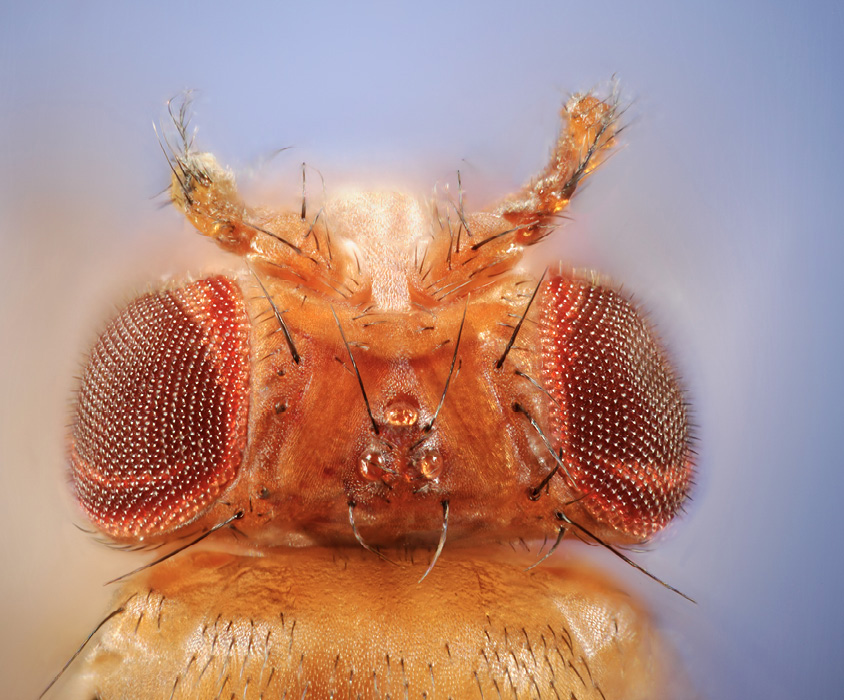
This fruit fly with the genetic mutation “antennapedia” has grown legs where antennae should be.
hox genes
Fruit flies (Drosophila) have been used in labs to study genetics for many years. One of the most famous mutated forms of Drosophila is a fly with legs growing out of its head instead of antennae. A mutation in a particular gene caused the larval imaginal disk that would normally give rise to an antenna to grow a leg instead. The gene, called “Antennapedia,” has been found to belong to a class of genes known as hox genes, which determine which types of appendages will grow out of which segments. Hox genes function as overseers or “managers,” determining the general body-plan of the insect by activating or deactivating other genes that build the actual body parts themselves.
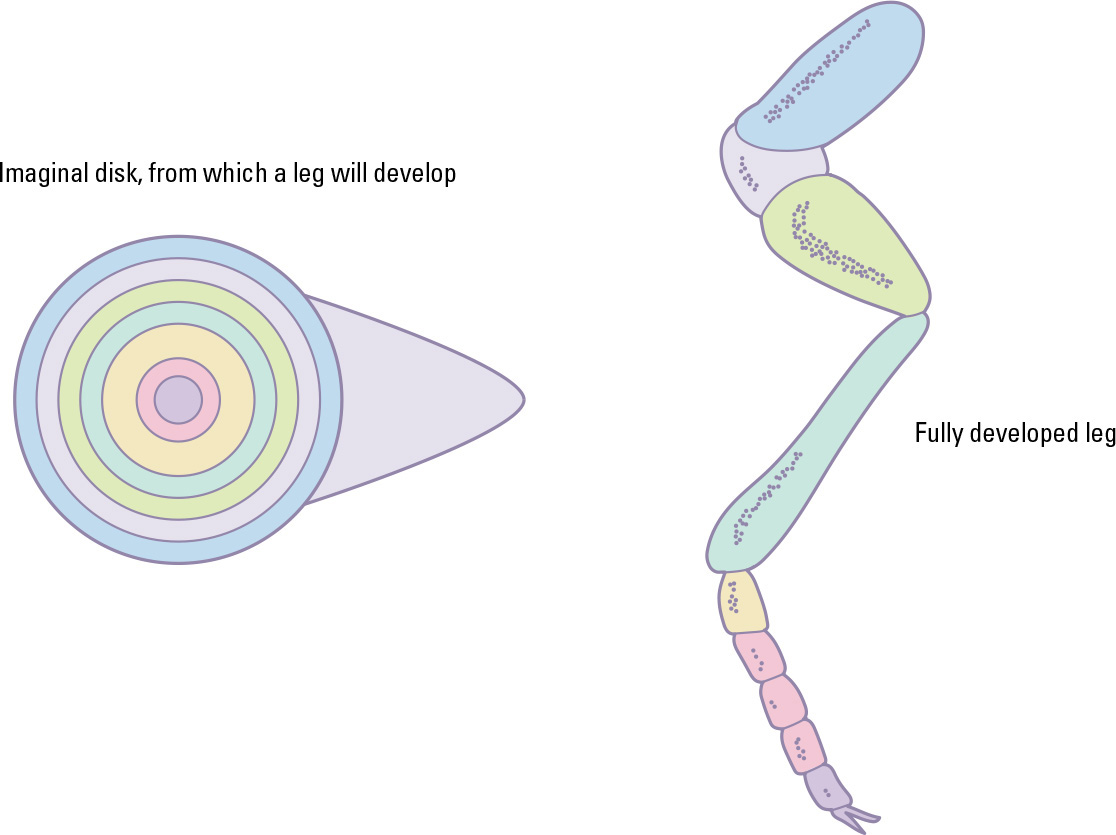
The various parts of an insect’s leg originate from different “zones” of the imaginal disk.
emergence
Once the adult insect’s body is fully formed within its pupa (or within its last larval cuticle, if it is hemimetabolous), it must undertake the last and perhaps most crucial molt of its life.
Emergence, or eclosure for holometabolous insects, occurs when the adult insect is fully formed, and when it senses that conditions are suitable for emergence. By this stage it is able to see and hear through the shell of its pupal or larval cuticle. Many insects emerge early in the morning, before full daylight, so they have the protection of darkness while at their most vulnerable. Fleas emerge from their pupae when they sense (through vibration) that a living host is nearby.
Some pupae have articulated mandibles, enabling the adult insect to bite its way free. In other cases, in both holometabolous and hemimetabolous insects, the emerging insect begins the process by arching and pushing its thorax upward. The pupal or larval cuticle fractures and the adult insect’s thorax appears, soon followed by its head and legs. Once the legs are free it can grip on to a nearby support (often the pupal shell or larval cuticle itself) and finally extract its tiny, crumpled wings and often very distended abdomen.
Once its entire body is free, the insect now spends some time (more than an hour is required for some large species) pumping up its wings and extending its abdomen, taking in air and using the resultant hydraulic pressure to push hemolymph through its system. The wings gradually uncrumple, flatten, and expand as hemolymph fills their veins, and the abdomen elongates, straightens, and narrows.

Emergence is a dangerous time for a butterfly, as it is helpless before its wings have expanded.
Although the emerging insect is soft-bodied, unable to move much, and extremely vulnerable to predators, it is also important that it has air space all around it to allow its wings and body to expand fully before the cuticle becomes stiff. Emergence in deep cover may reduce the risk of predation, but if a twig or other obstacle gets in the way, the insect may end up with a permanently crumpled wing or wings, which would affect its ability to fly, or a bent body that cannot function normally. Other mishaps that can occur during emergence include legs getting stuck and breaking off, and part or all of the pupa or exuvia remaining stuck to a part of the insect’s body—the former is a survivable handicap, but the latter may not be.

It greatly benefits mayflies to emerge in large groups, given their brief adult life span and urgent need to find a mate and reproduce.
mass emergence
Many species of insects show highly synchronous emergence, with large numbers of individuals all taking to the air on the same morning. The advantages of this are clear—predators will be overwhelmed, increasing survival chances of each individual, and the insects will be more likely to find a mate quickly. How, though, do they achieve the synchronicity? Studies on the periodical cicadas, populations of which emerge en masse every 13 or 17 years on the same day, show that, while the cicada larvae only reach maturity at the “right” age, actual emergence is triggered by an outside factor—the temperature of the soil in which they live. Temperature is also the key factor in triggering emergence of winged ants, while studies on mayfly emergence in rivers suggest that a fall in water flow rate may also be involved.
maturation in adulthood
Emergence in its adult form means the insect will no longer molt, but this is not necessarily the end of the process of maturation. Further changes may occur before it is truly a fully fledged adult.
An insect that is freshly emerged is described as “teneral.” In some groups, teneral insects are easy to spot. Dragonflies and damselflies, for example, show muted colors when freshly emerged. Their drab appearance not only provides camouflage from predators but also helps them to avoid competition with and unwanted sexual attention from fully mature adults. Their behavior is also different from mature adults—they immediately move away from the water and spend a day or more hunting in nonaquatic habitats. Only when fully mature, resplendent in their full adult colors, and ready to seek a mate will they return to the waterside. Some immature female damselflies actually have coloration typical of mature males, only developing a female-typical appearance when they are old enough to mate. Copulation is risky for the females and this is only one of several tactics they may use to avoid it (another is to feign sudden death and drop to the ground).

Male Heliconius hewitsoni butterflies surround a pupa, competing to mate with the emerging female butterfly.
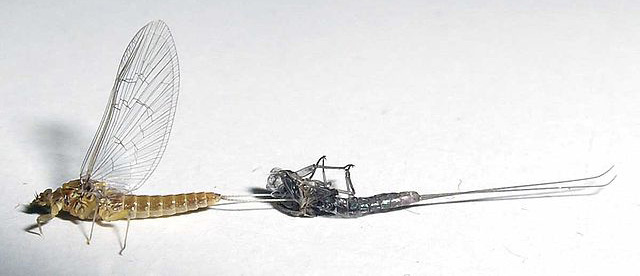
The subimago mayfly undergoes a final molt to emerge as a fully mature adult.
The activities of an adult worker honeybee change through its life but usually follow the same general pattern. When it first emerges, it cleans out the wax cell in which it developed, and then assists with cleaning other cells nearby. It then helps to feed growing larvae, before moving on to act as a guard at the nest entrance. It leaves the nest to begin foraging for nectar and pollen after three weeks of adulthood, and it will then be a forager until the end of its life (probably another two or three weeks later). Any worker bee that is injured during emergence and cannot fly can still be a useful member of the nest workforce.

The tasks of a worker honeybee change as it ages—only the oldest bees actually leave the nest to forage for nectar.
Female moths and butterflies are sexually mature on emergence, and some even attract a mate before emerging. Aromatic chemicals (pheromones) are released by females still in their pupae, which males can detect. Male Heliconius butterflies emerge before females, and home in on a female pupa. Each tries to perch on the pupa and fend off other males, and then tries to mate with the female butterfly as soon as she begins to emerge—this is known as pupal mating. Chemicals that mimic these female pheromones can be synthesized in the laboratory and used to attract male moths of particular species, for purposes of study or pest control.
winged molt
Mayflies are unique among insects in that they undergo one final molt in their fully winged form. The so-called subimago or dun form, which emerges from the aquatic wingless larva, molts once more soon after it has emerged and flown to a safe place away from the water. It breaks out through the top of the thorax in the usual way, even pulling a fresh set of wings from inside the subimago wing cuticle. Now in its final form, it returns to the water to seek a mate.